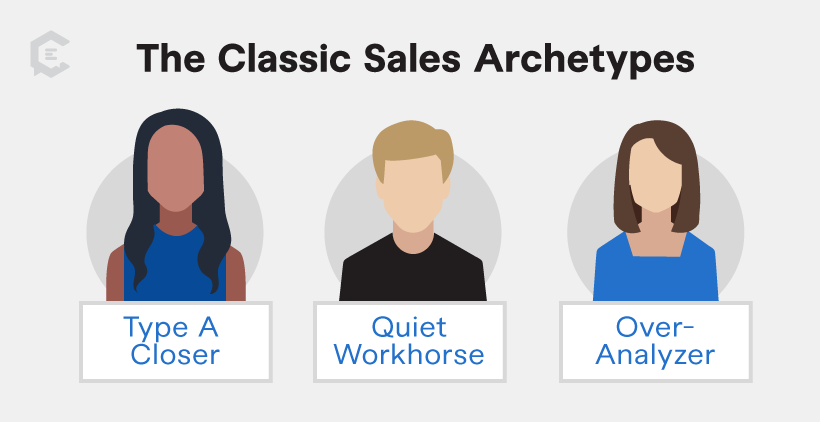Not long ago, in-person and telephone salespeople operated from pre-written scripts that contained high-powered, persuasive, and urgent words. The purpose of the verbiage? To get the customer’s attention and push them into buying a product or service (whether needed or not).
However, sales consultant and author Scott Leese has a different take on this old-fashioned sales archetype. Customers and prospects are more knowledgeable and sophisticated than their parents and grandparents. They resist being pushed into anything. Today’s salesperson needs to ditch the cold calls and canned pitches and change their approach to stand out.
In this article, you’ll learn why personalization and authenticity now outweigh scripts and pressure tactics, and why today’s salespeople need creativity and writing chops — not just closing experience.
The Classic Sales Archetypes (and Why They’re Outdated)
So what are those old-fashioned sales models? Let’s take a look.
The Type A Closer
The Type A is the stereotype for sales: a highly competitive and results-oriented individual. “This is the personality that is the loud life of the party,” Leese commented. “Sometimes in a good way. Sometimes in a bad way.”
However, today’s buyers are wary of hard-sell tactics, making this aggressive approach appear pushy and inauthentic.
The Quiet Workhorse
At the other end of the spectrum is the salesperson who focuses on empathy, relationship-building, and listening. But this archetype can also lack confidence. Said Leese: “If you don’t heal that person’s defective insecurity, they’re not going to thrive.”
The Over-Analyzer
This archetype is dedicated to facts and data. While reports and intel can help support a sales pitch, Leese said that this individual might be too slow and calculated to shift gears quickly if a situation changes.
Why Sales Needs a New Breed of Talent
Today’s environment — not to mention prospects — requires up-to-date salespeople who can handle the following.
Overcoming Buyer Skepticism Requires Authenticity (Not Canned Scripts)
Artificial intelligence is everywhere in marketing. “We’re at a place where I think everybody is extremely suspicious of any piece of written content at all, and whether it’s authentically human,” Leese noted.
He explained that the successful sales individual will do everything in their power to prove they’re a human, not a programmed chatbot. “The only way to be unique and different is to do things that prove your humanity,” he added.
Exceeding Customer Expectations Requires Personalization at Scale
Today’s prospects and customers want the personal touch.
In one instance, Leese had some difficulty making a sale with a Chicago-based company. The problem? The two partners said they didn’t have time to discuss it with one another.
With some digging, Leese learned that the partners liked baseball; one cheered the Cubs, while the other was a White Sox fan. Leese sent two tickets to a Cubs-White Sox home game, suggesting the partners discuss the sale proposition there.
“They took a selfie at the game, texted it to me, and said ‘hey, thanks for the game,’” Leese said. The partners also had their talk and told Leese to call them to discuss the details of the sale.
Getting in front of prospects is one thing. Personalization takes it further. “That stuff is mattering more and more,” Leese said. “And that’s how you’re going to stand out.”
Cutting Through Content Saturation Requires Originality and Authority
There’s a lot of content out there these days. Leese noted that many people continue to push out blog posts, emails, and other types of content, which muddies the messaging waters. Additionally, a lot of low-quality, spammy content makes it difficult for the good stuff to shine.
So, yes. Salespeople need to be good writers.
“Salespeople of my age or older will tell you that one of the reasons they got into sales was because they weren’t good at math or English,” Leese said. Charm and an ability to talk were more than enough.
That doesn’t fly these days.
Salespeople can fight the saturation battle by providing high-quality, targeted content that is well-written and focuses on Experience, Expertise, Authoritativeness, and Trustworthiness (E-E-A-T).
Leese said he also maintains a strong sales personal brand. In fact, he’s been writing posts on his LinkedIn profile for years and currently boasts 125,000 followers. “All of my business comes through these social platforms,” he added. “If I didn’t know how to write and didn’t practice it, that’s a whole channel that disappears.”
So, What Other Skills Do Modern Salespeople Need?
The modern sales archetype requires a mix of essential sales skills that go far beyond persuasion and product knowledge.
Constant Curiosity and Creativity
Salespeople must be in learning and experimentation mode, 100% of the time. Leese acknowledged that reading a book or studying online is difficult when a salesperson is expected to execute all day long.
But finding salespeople with a continuous learning mindset is important.
“You’re driving around, shuttling your kids all over the place. Are you listening to music? Or are you listening to a podcast about the latest and greatest (sales) tools?” he said. “I am constantly trying to find ways to insert learning into my day.”
The best salespeople today are also creative salespeople — designing personalized outreach strategies, experimenting with new channels, and finding innovative ways to start conversations. Instead of following a script, they tailor approaches for each prospect, blending storytelling, social proof, and even content assets to spark interest and build trust.
Personal Branding Capacity
What is the role of personal branding in sales? The short answer is that sales branding gets your sales team (and by extension, your company) noticed, especially in a competitive industry.
The longer answer is that sales teams that focus on personal branding are considered more reliable, credible, and trustworthy by their customers.
Leese boosts his personal brand with LinkedIn posts and comments. The social media platform is also a source for generating leads. When people tag him with questions on other social media platforms like Instagram, he suggests they direct message him on LinkedIn. “If they’re willing to take that extra step, then I feel like they’re a little bit more serious and a bit more qualified as a lead,” he said.
Additionally, Leese’s branding and LinkedIn network (what he calls the “network playbook”) can shorten sales cycles.
For example:
- Person A (the salesperson) is friends with and has a first LinkedIn connection with Person B.
- Person B is friends with and has a first LinkedIn connection with Person C, a sales prospect for Person A.
- Person B introduces Persons A and C.
- The latter agrees to meet with the former, as Person B provided a trustworthy referral bridge.
“All three parties are happy at that point,” Leese commented. “This is the fastest, easiest, most cost-effective revenue channel that there is.”
But the key to this approach is a trust-building social media presence. This means your salespeople should have high-quality headshots, fully optimized profiles, and consistently post or share videos that showcase their expertise.
Leese also explained that a salesperson using the network playbook to scale revenue doesn’t risk brand damage from overdoing it with cold calling or emailing. This type of authentic, content-driven sales approach positions the salesperson as a trusted expert, helping to close deals.
An Ability to Understand KPIs
The classic sales archetype measured key performance indicators like calls, contacts, and quotas. Certainly, calls and contacts should still be measured. However, the salesperson’s KPI universe has expanded to metrics covering network growth, thought leadership, number of follow-ups, data entry, revenue, and more.
Tracking engagement with content, brand mentions, and inbound opportunities is now just as important as traditional numbers. While focusing on such details may not be a strong suit for many salespeople, “it helps them stand out,” Leese noted.
Embracing the Modern Sales Archetype
A couple of decades ago, Leese said he would have been handed a sales script with a list of people to call. Then he’d have been told to go sell without asking questions.
“But that doesn’t work anymore,” he said. Curiosity, network growth, personalization, and content are integral to today’s modern sales archetype.
Still, don’t dismiss the traditional activities. Leese pointed out that successful salespeople today are driven, ambitious, and know how to listen — just like in the “olden days.”
ClearVoice’s team of content strategists, writers, SEO specialists, and more has the expertise to create content that supports your sales efforts. Connect with a content specialist today to help your salespeople see more success.





